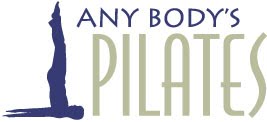CAUTION: If it is shooting pain or pain like fire -- lower your head and tell your instructor immediately! Do not attempt to "work through" acute pain -- your instructor should provide a modification for you.
However, if the "hurt" is not acute, it is probably muscle pain and part of the strengthening process. For many people, lifting their head with their gaze to the navel stretches the muscles in the back of the neck in a way those muscles have not been stretched in a long time, while challenging their abdominal muscles to hold up the head. Straining to do so, the client may clench the muscles around his/her neck, jaw and chin, causing fatigue and slight muscle pain. Relaxing the mouth, neck and chin will help, as will lifting the head to the correct position, then lowering for a brief rest.
 |
| Hundred on the Reformer |
Developing strength and flexibility may take practice and time. Clients should endeavor to hold their heads up in the correct position for as long as possible, lowering for a brief rest, then raising again. Not raising to the correct position may cause more pain and less positive results than lifting to the correct position, resting and resuming.



